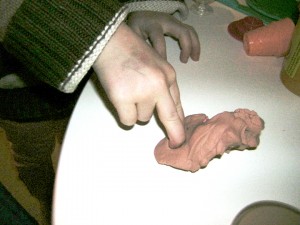What do kindergarten readiness, science, and playdough all have in common? Fun and learning for young children, of course. Playdough is a fun and inexpensive toy. I prefer making the kind that cooks on the stove but I have made many batches with boiling water. In either case, it’s safer to make these without any help and wait until the playdough cools before letting little hands play.
 Since this month, blog posts are about science learning, part of science is exploring the 5 senses. Playdough is great for the sense of touch. Ask your child what it feels like: Is it warm or cool? Rough or smooth? Heavy or light? For hearing, have a listen: Is it making any noise? If you have used kooloid for color, the playdough may have a smell. A few drops of essential oil just as peppermint, or a bit of cinnamon also smell nice in the dough and on the hands.
Since this month, blog posts are about science learning, part of science is exploring the 5 senses. Playdough is great for the sense of touch. Ask your child what it feels like: Is it warm or cool? Rough or smooth? Heavy or light? For hearing, have a listen: Is it making any noise? If you have used kooloid for color, the playdough may have a smell. A few drops of essential oil just as peppermint, or a bit of cinnamon also smell nice in the dough and on the hands.
(Because it’s not made for eating, it isn’t good for tasting, but kids may notice that their hands have a salt taste if they happen to lick a finger.)
There’s lots for eyes to see: shapes, colors, and sizes. The playdough may look like something else, such as a ball or pancake. Show your child that it’s magic, too. We can break the playdough all apart and abracadabra, put it all back together. Sometimes, science does seem like magic. Cutters can make different shapes. Rolling over will erases any lines. Putting playdough on something leaves lines on the inside. In the video below the little one is very involved and making all kinds of brain connections, too. Can you mix a batch of playdough, for some science and kindergarten readiness learning and fun, for your child?
